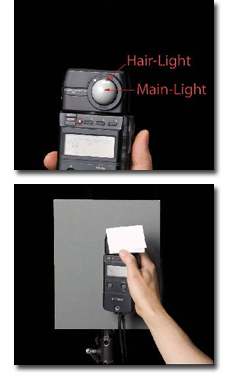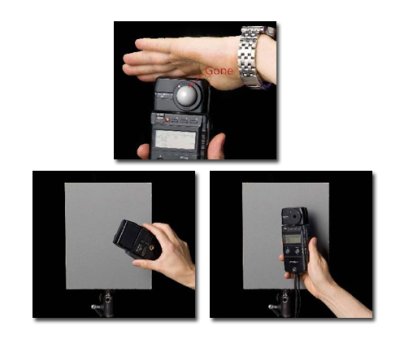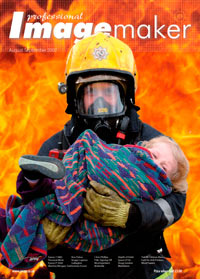articles/Lighting/makeyourownincidentmeter-page1
Make Your Own Incident Meter - part 1 of 1
by Dave Montizambert Published 01/08/2007

You can actually make your own incident meter from a reflective meter. Here's how: set-up a grey-card, take a reflective meter reading off its surface, (see Image [3]), remember this reading, then orientate the back of the meter towards the grey-card so that its receptor is pointing directly at the light source you want to read (see Image [4]). If you should happen to take a reading at this time, it will read much higher than the reflective reading off the greycard. Now hold a piece of white paper tightly against the meter's receptor so that the light has to pass through the paper to hit the chip, (see Image [5]). Take another meter reading with the paper-covered receptor pointing directly at the light source.
If the reading still does not match the reflective reading then fold the paper over and try again. Fold the paper over as many times as necessary until you have added enough density over the receptor that the two readings are equal. Now the paper is absorbing as much light as is the grey pigment coating the grey-card and it is this fact that makes it possible for an incident reading of the light striking an area to read the same as a reflective reading off a grey-card, only without a grey-card - what a convenience! Better yet, forget the white paper, the white incident dome that comes with your light meter does the same thing only is a more convenient accessory than is white paper, so by all means use it!

And now a handy incident metering trick: When you are metering with the white incident dome attached to your meter, look at the dome, you will see a reflection on its surface from the source you are pointing it at. If you are using multiple sources such as main, fill, separation, and hair light, look for reflections on the dome from these lights to see which are contributing to the exposure.
I typically like to read my sources separately to see what each light's value is, then I know exactly what the ratio between my lights are. A hair light for instance, can influence the reading of my main-light (see Image [6]), looking at the dome guides my hand to the best position to block that separation light from the dome and from my reading (see Image [7]). Many lighting experts use flat incident disks for this purpose, however, I find flat disks are very angle sensitive and so require more care than I want to give during the heat of the battle. Many ask me, "Well, doesn't your hand reflect some light back onto the dome as well thus influencing the reading?" to which I answer, "Yes, but not enough to matter."
You are currently on page 1 Contact Dave Montizambert
1st Published 01/08/2007
last update 09/12/2022 14:56:17
More Lighting Articles
There are 0 days to get ready for The Society of Photographers Convention and Trade Show at The Novotel London West, Hammersmith ...
which starts on Wednesday 15th January 2025





